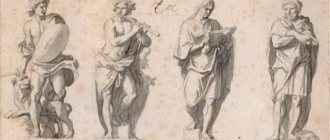The topic to which this article is devoted has been of concern to the global scientific community for several decades - it is directly related to the individual personal characteristics of people.
Everyone knows that the psyche of each person is unique. And this is connected both with the physical and biological characteristics of the organism, and with a complex of social characteristics. If we talk about biologically determined substructures, then, mainly, we need to consider temperament.
The basis of personality
Temperament is a certain biological basis on which personality is built. Temperament determines the mechanisms of psychological activity and the ability to socially adapt. On its basis, social properties of the psyche are formed. From a physiological point of view, temperament is a type of higher nervous activity.
Scientists consider Hippocrates to be the father of the theory of human temperament. Later, the philosopher and physician Claudius Galen developed this theory and became the author of the scientific treatise “Correct Measure.” This work describes four types of temperament according to basic biological substances. Blood plays a key role in the formation of the sanguine type. For a choleric person, the main substance is bile. The phlegmatic type develops under the strong influence of phlegm. And melancholic in a person is determined by the so-called “black bile”.
No type of temperament is found in its pure form. Every person has a basic temperament, developing or suppressing it depending on circumstances. In different situations, the same person is capable of exhibiting traits of all four types.
Abstract on the academic discipline “Psychology”
on the topic: “Human temperament, its types and characteristics”
Plan
1. Introduction.
2. The concept of temperament, history of origin and its physiological basis.
3. Types of temperament and their characteristics.
4. The influence of temperament on a person’s position in society.
5. Conclusion.
6. List of references.
1. Introduction.
The problem of temperament, associated with the obviousness of individual differences between people, has been of interest to world society for more than 25 centuries.
The psyche of each individual is exceptional and unique. Its uniqueness is associated with the characteristics of the development of the body, physiological and biological structure, as well as with the unique structure of social communication. In the biological interdependent substructures of personality there is, initially, temperament. When discussing temperament, we mean many mental differences between people - differences in intensity, depth, stability of emotions, energy of action, sensitivity, tempo and other individually stable, dynamic features of mental activity, life and behavior.
And yet, temperament is also currently recognized as a largely ambiguous and unresolved problem. However, with all the diversity of approaches to the problem, practitioners and scientists believe that temperament has a general biological root that shapes a person as a social subject.
Temperament is a reflection of the dynamic aspects of behavior, mostly of a genetic nature, therefore the properties of temperament are particularly constant and stable in comparison with other mental characteristics of the individual. The most specific feature of temperament is that the different properties of a person’s temperament have a natural connection between each other, forming a distinct organization that characterizes 4 temperaments.
People have long tried to realize and highlight the classical features of the mental formation of different personalities, trying to reduce many images to their smallest number of schematic images. Since ancient times, such schematic images have been called types of temperaments.
Typologies of this kind were useful in practice, thanks to them they predicted the behavior of a person with a specific temperament in any current situation in his life.
2. The concept of temperament, history of origin and its physiological basis.
Temperament is a complex of typological characteristics of a person that manifest themselves during the development of his psychological processes: in the emotional activity of his life, in the strength and speed of his reaction.
Temperament is the awakening of the genuine type of nervous activity in the human psyche. As a result of this, the characteristics of temperament include, first of all, individually unique and innate personality traits.
The word “temperament” is translated from Latin as “proper ratio of parts”; equally important, the Greek word “krasis” was introduced by the ancient Greek healer and physician Hippocrates; he believed that temperament is the individual psychological, anatomical and physiological characteristics of a person.
For one person, mental activity is invariably smooth. Such a person is outwardly calm, balanced and, in a sense, slow all the time. He rarely laughs, his gaze is always cold and stern. In difficult circumstances or a funny situation, he remains outwardly calm. His gestures and facial expressions are not distinguished by their expressiveness and variety, his gait is firm, and his speech is calm. In another person, psychological activity proceeds unevenly. He is extremely active, restless and noisy. His speech is passionate and impetuous, his facial expressions are rich and varied, his movements are chaotic. Often such a person waves his arms and stomps his feet when talking. He is impatient and fussy. The properties of temperament are natural properties that determine the dynamic side of an individual’s mental activity. In other words, the nature of the course of mental activity is determined by temperament, or more precisely:
- the speed of emergence of mental processes and their constancy - speed of perception, long-term concentration of attention, mental alertness;
- mental tempo and rhythm;
- the degree of manifestation of mental processes - the activity of the will, the strength of emotions;
- the focus of mental activity on any specific objects - a person’s constant desire for fresh impressions of reality, for new contacts, or the individual’s focus on himself, on his ideas and images.
In addition, the dynamics of mental activity are determined by the mental state and motives. Each individual, of course depending on the characteristic features of his temperament, works faster and more energetically when there is interest than when there is no interest. For every person, a happy event creates an increase in physical and mental strength, and an unhappy event creates a decline in strength. Conversely, the properties of temperament are expressed identically in a variety of activities and for a variety of purposes. For example, if a student is nervous in anticipation of an exam, anxious before speaking at an open lesson, or nervous before starting a sports competition, this means that increased anxiety is a property of his temperament. The properties of temperament are particularly constant and stable in comparison with other mental characteristics of a person. Different properties of temperament are determined by the connection between themselves, creating a certain structure that outlines the type of temperament.
When compiling psychological characteristics of the common four types of temperament, the following basic properties of temperament are distinguished:
Sensitivity is determined by the minimum force of external influences necessary for the formation of a particular psychological response.
Reactivity is characterized by the magnitude of impulsive reactions to internal or external influences of the same type of force - unpleasant words, rude tone, strong sound, critical remarks.
Activity determines how intensely an individual influences the outside world and overcomes barriers to achieving a goal - focus, concentration, assertiveness.
The correspondence of activity and reactivity establishes, to one degree or another, the dependence of human activity - incidental internal or external factors (state of mind, random phenomenon) or goals, intentions, beliefs.
Rigidity and plasticity determine the pliability of a person’s adaptation to external influences or the extent to which his behavior is rigid and inert.
The pace of reactions represents the speed of passage of various mental processes and reactions - speed of mind, rate of speech, activity of gestures. Introversion and extraversion determine the predominant dependence of an individual’s activity and reaction on external impressions - those that arise in the present - an extrovert, or on images, thoughts, ideas that are associated with the future and past - an introvert. Emotional excitability is how little influence is needed to form an emotional reaction and what is the speed of its formation.
Hippocrates, followed by Galen, defined temperament as behavior characteristics, with the predominance of one of four elements in the body:
- the prevalence of yellow bile - the person is impulsive, “hot” - choleric;
- prevalence of lymph - the person is calm and slow - phlegmatic;
- predominance of blood - a person is active and cheerful - sanguine;
- prevalence of black bile - the person is sad and fearful - melancholic.
Undoubtedly, the paradigm of I.P. turned out to be a turning point in the history of natural scientific research on temperaments. Pavlova on the types of nervous system common to humans and higher mammals. I.P. Pavlov confirmed that the physiological basis of temperament is the type of higher nervous activity, which is determined by the correlation of the fundamental properties of the nervous system - the balance and mobility of the processes of inhibition and excitation, the strength that occurs in the nervous system. In turn, the type of nervous system is determined by the genotype - the hereditary type. I.P. Pavlov emphasized four clearly described types of the nervous system, otherwise determined by complexes of basic properties of nervous processes.
The subtle type is characterized by the subtlety of excitatory and inhibitory processes - melancholic. A strong, hot-tempered type is characterized by a powerful nervous process and a relatively powerful process of inhibition - choleric people are an indomitable type. A strong, balanced, dynamic type - sanguine people - a lively type. A strong, reserved type, but with inert nervous processes - phlegmatic people - a calm type.
Strength is the ability of nerve cells to maintain normal functionality at high intensity of excitation and inhibition processes, the ability of the central nervous system to carry out deterministic work without the need to regenerate its capabilities. A strong nervous system can withstand significant stress over a long period of time, and, on the contrary, a fragile nervous system cannot tolerate immeasurable and long-term stress. It is believed that individuals with the strongest nervous systems are more resistant to stress. The strength of the nervous system in terms of excitability is expressed in the relatively easy performance of work by a person in a difficult environment; a short break is enough for him to renew his strength from hard work; he can work hard, does not get lost in an unfamiliar situation, and is assertive. The power of the nervous system to inhibit is a person’s ability to limit his activity.
The balance of nervous processes reflects the correlation, the balance between inhibition and excitation. Moreover, balance means identical explicitness of nervous processes. The mobility of the nervous system is expressed in the possibility of rapid change from one process to another, from one activity to another. A person with a predominantly mobile nervous system is distinguished by dexterity of behavior and adapts better to a different atmosphere. Describing the characteristics of different temperaments helps to understand the qualities of an individual’s temperament, when clearly expressed. People with clearly manifested qualities of a certain temperament are rare; mixed temperaments in different combinations are more common. At least, the dominance of qualities of a certain type of temperament makes it possible to correlate a person’s temperament with one or another type.
3. Types of temperament and their characteristics.
Sanguine.
A cheerful sanguine person is open to communication, quickly moves from one activity to another, but he does not like the monotony of work. He freely maintains control of his emotions, quickly adapts to an unusual situation, and is active when interacting with people. His speech is loud, fleeting, intelligible, and is accompanied by eloquent gestures and facial expressions. However, this temperament is characterized by some duality. In the case when stimuli change rapidly, innovation and interest in impressions are maintained throughout the entire time, the sanguine person goes into a state of intense excitement and positions himself as an enterprising, enterprising, dynamic person.
In the case of prolonged and monotonous exposure to stimuli, the state of excitement and activity is not maintained, the sanguine person loses interest in the matter, lethargy, indifference, and despondency arise. A sanguine person quickly manifests such feelings as fun, sadness, likes and dislikes, but these manifestations are unstable, fleeting and superficial. They are due to their transience both during manifestation and disappearance; they are even replaced by the opposite ones. There is a rapid change in mood, but, as a rule, a good mood dominates.
Choleric.
A person of this temperament is impetuous, hyperactive, unbalanced, easily excitable, all mental processes are intense and rapid. The dominance of excitation over inhibition inherent in this type is distinguished by a clear expression of incontinence, impulsiveness, hot temper, and nervousness of the choleric person. As a result, there is a manifestation of vivid facial expressions, hasty speech, harsh gestures, and intemperate movements. A person of choleric temperament exhibits strong feelings, which, as a rule, are expressed vividly and arise rapidly; in some cases there is a sharp change in mood. The inherent imbalance of a choleric person is strongly manifested in his work: he gets down to business with increasing intensity and passionate desire, while demonstrating impulsiveness and swiftness of movements, he works with inspiration, overcoming obstacles.
However, in some cases, in a choleric person, the resource of nervous energy quickly runs out during activity, and then a sharp decrease occurs: passionate desire and enthusiasm disappear, and the mood suddenly worsens. When making contacts in society, a person of the choleric type allows himself to be rude, quick-tempered, and can be emotionally unrestrained; this often prevents him from adequately perceiving the actions of people; on this basis, he has disagreements in the team. Excessive directness, ardor, rudeness, and intransigence sometimes make it difficult and unpleasant for such a person to be in the company.
Phlegmatic person.
Phlegmatic people are slow, serene, unhurried, calm. They show seriousness, reasonableness, and assertiveness in their activities. They usually finish what they start. In people of this type, all mental processes proceed at a slow pace. The emotions of a phlegmatic person are weakly detected in appearance; as a rule, they are inexpressive. This factor is self-control, calmness and weak mobility of nervous processes. When making contacts in society, a person of phlegmatic temperament is constantly restrained, balanced, knows when to stop when communicating, and has a stable mood.
The balance and equanimity of a phlegmatic person is expressed in his attitude towards the phenomena and events of life; it is difficult to disturb his emotional calm, to touch a nerve. It is not difficult for a person of this type of temperament to develop self-control, calmness, and self-control. Also, a phlegmatic person needs to develop qualities that he lacks - greater mobility, initiative, and not allow indifference to work, weakness, contemplation, which are easily formed under certain circumstances, to manifest themselves. Occasionally, a phlegmatic person may experience indifference to work, to the world around him, to society and to himself.
Melancholic.
In people of melancholic temperament, mental processes proceed slowly, and it is difficult for them to react to fundamental stimuli. Long and very significant tension contributes to the slowdown of their activities, and then to their completion. Melancholic people are usually inactive at work and rarely show interest, since this requires intense nervous tension. Emotional states and feelings in a person with a melancholic temperament manifest themselves slowly, but have significant strength, depth and duration. Melancholic people are vulnerable, they have a hard time dealing with insults and troubles, although you can’t tell by their appearance.
People of a melancholic nature are withdrawn and lonely, avoid contact with unfamiliar people, are often shy, and express great embarrassment in an unfamiliar situation. Something exceptional, unusual, provokes a state of inhibition in them. However, in a calm and familiar environment, melancholic people feel peaceful and perform their work very effectively. It is easy for melancholic people to develop and improve their inherent stability and depth of emotions, and high sensitivity to external influences.
4. The influence of temperament on a person’s position in society.
The characteristic features of a person, determined by temperament, are manifested in emotional agitation, to a certain extent, an orientation toward the external manifestation of feelings, haste in movements, general activity, sensitivity, and restraint.
In research by Russian scientists, sociability is associated with types of temperament. According to the paradigm of A.G. Kovalev, the sanguine type of temperament sets the pace of entry into relationships, when there is no constraint in contact with people unconditioned by their social status, easy adaptation to the new environment is observed. A person of a melancholic type of temperament, on the contrary, is unsociable, lost and fearful in new conditions, and prone to loneliness.
A.I. Ilyina in her research confirms that the sanguine type of temperament is characterized by speed of reaction upon contact, ease of acquaintance, wide circle of friends, energy, but there is also variability in communication. People of phlegmatic temperament, on the contrary, express slowness in interaction, are inactive during contacts, have difficulty getting along with people, but are stable in maintaining communication.
Among the different types of interpsychic relationships, sympathies and antipathies occupy an important place, since during their formation a person’s individual traits play a significant role.
When forming interpsychic relationships in a group of girls, O.V. Lomtatidze discovered dominant directions in the expression of likes and dislikes, determined by the type of temperament.
The author identified the characteristic features of interpersonal relationships in girls with different types and qualities of temperament, more precisely, when expressing likes and dislikes. The focus on acceptance undoubtedly differs among the sanguine, choleric and phlegmatic types.
Sanguine people are distinguished by a greater zeal for acceptance, while phlegmatic people have a lower zeal. The average values of the motive are fear of rejection; undoubtedly, the phlegmatic and choleric types differ from the sanguine type.
Choleric girls actively enter into interpsychic relationships with representatives of their sex with a dominant type of temperament - choleric, melancholic or sanguine.
Sanguine girls are distinguished by the abundance of relationships with choleric people. Mutual likes and dislikes are found to the least extent during contacts with melancholic people.
Interpsychic relationships in melancholic girls are found with representatives of the same sex of choleric and choleric-sanguine temperament types, while the latter have only antipathies.
There are consistent differences between the likes and dislikes of choleric people and other types of temperaments. Cholerics appear to be a dynamic principle in the creation of both positive and negative interpsychic relationships.
Extroverted girls keep their level of sympathy at an average level. In introverted girls, mutual expression of sympathy is manifested at a low level.
The most constant sympathies were found in pairs: sanguine-phlegmatic, sanguine-melancholic, melancholic-melancholic, the maximum instability in sympathies is expressed in pairs: phlegmatic-melancholic, choleric-choleric.
Characteristics of temperament are of significant importance in the process of harmony and comparability of people in joint activities. N.N. Obozov determined that maximum sociability of people in production is possible in teams and units, in addition, in family and marital relationships when combining people with polar temperaments. Thus, under other equal circumstances, it is easier for a phlegmatic person to act with a sanguine person, for a melancholic person - with a phlegmatic person, and for a sanguine person - with a melancholic person.
Types of temperament, as noted by R.M. Granovskaya, leave their own mark on communication methods, determining the level of initiative in establishing contacts.
This is how sanguine people instantly establish social contacts. They have no desire to become despondent, to surrender to the will of their fears and sad thoughts. In communication, they are initiators, easily enter groups, and are ready to win a dominant place in them.
Cholerics, who are distinguished by excessive activity and impulsiveness, also instantly establish interpsychic contacts. However, if people during communication for some reason do not meet the hopes of the choleric person, then he soon loses all interest in them and establishes new connections. The choleric person must be constantly occupied with useful work, otherwise he can become the basis of interpsychic conflict situations in the team.
Phlegmatic people make social contacts slowly. In the new society, they probably close themselves in their “shell”. Phlegmatic people express their emotions weakly, for a long time they do not feel that someone is actively attracting their attention, however, they are stable and constant in their connections, preferring to be in a small company of old friends, in a familiar atmosphere.
Melancholic people are distinguished by indecision, caution in contacts, and a high subconscious perception of the disposition of loved ones and others. Excessive sensitivity provokes in them a constant need for empathy. Actually, the feeling of empathy turns out to be a kind of impulse for a melancholic person to establish contacts in society.
Temperament reveals a person’s disposition to the phenomena occurring around him. Each person is obliged to always take into account the characteristic traits of the temperament of another person with whom he happens to work and come into contact. This is a successful interaction with them, reducing the likelihood of acute conflict situations. Efforts in contact with people should be a guideline not for changing the situation, but for the skillful use of worthy qualities and positive aspects of temperament while simultaneously eliminating negative manifestations. In accordance with the type of temperament, different people have different directions in likes and dislikes, in the consistency and collaboration of people, in establishing social contacts.
5. Conclusion.
Even today, researchers cannot definitely decide whether to consider temperament to be a genetic quality, or whether the role of the environment in the formation of temperament is key. All this points to the phenomenon of temperament as a complex process, the study of which has not given clear answers for a long time.
The conditioning of temperament by a single type of nervous system leads to the understanding that the psychological signs of temperament are only constant and persistent individual characteristics that persist over a long time.
What makes temperament so fascinating is that modification of at least some of its traits and specifics requires exceptional changes in living conditions and the most difficult situations. Thus, research into the characteristics of temperament can be useful, because understanding the type of temperament makes it easier to communicate with people and contributes to the beneficial building of relationships.
During this period, the interconnection of temperament with various individual characteristics of a person and style of activity was studied; the relationship of temperament with character, capabilities, emotionality, relationships between people.
In accordance with their temperamental characteristics, people differ not in the final outcome of their actions, but in the method of achieving results. At the basis of determining the properties of temperament and specific character, the professional suitability of an individual for various fields of activity is established.
6. Bibliography.
1. A. V. Batarshev, Temperament and character: Psychological diagnostics / A. V. Batarshev. - M.: Vlados press, 2001. - 336 p.
2. E.A. Golubeva, Abilities. Personality. Individuality / E. A. Golubeva. - Dubna: Phoenix+, 2005. - 512 p.
3. Differential psychology and differential psychophysiology today: materials of the conference dedicated to the 115th anniversary of the birth of B. M. Teplov, November 10-11, 2011 / ed. M.K. Kabardova. - M.: Smysl, 2011. - 380 p.
4. Differential psychophysiology: educational and methodological manual / Comp. O. V. Gribkova. — Samara: Samar. Human. acad., 2008. - 120 p.
5. A.D. Ishkov, Student’s educational activity: psychological factors of success: Monograph. - M.: ASV, 2004. - 224 p.
6. O.V. Lomtatidze, The influence of temperamental characteristics on the formation of likes and dislikes in girls. - Ekaterinburg, 2008. - 24 p.
Properties of temperament
Each type of temperament is determined by the presence of specific properties, namely:
Extraversion and introversion
These qualities are based on emotional reactions, on the speed of volitional actions.
Activity and passivity
These properties show a person’s reaction to negative events and difficulties, and also determine the degree of his endurance, perseverance and determination.
Sensitivity
It manifests itself in the strength of the influence of external stimuli that force the psyche to react in one way or another. Different people react to the same event in completely different ways.
Reactivity
This term refers to an involuntary reaction of the psyche to irritating factors (they can be both external and internal).
Plasticity and rigidity
These qualities show a person’s ability to adapt to the environment and adapt to new circumstances.
Reactive Activity Rate
This property determines how quickly the psyche reacts to external stimuli.
Emotional excitability
Using this property, you can determine how much a person is able to control his emotions, speech and mental reactions.
Character types
People's characters, like their temperaments, are divided into types, but the classification of characters is very different from the typology of temperaments. When extreme combinations of temperament characteristics are called temperament types, extreme character traits are called accents. This concept comes from the word “accent” - emphasis, emphasis. Character accents are people who have highly developed character traits that go beyond the norm. For example, a person may have strong character traits such as friendliness, sociability, optimism, or the opposite negative traits: aggression, isolation, pessimism. Strictly speaking, almost every person is an accented person in some sense of the word, because at least one of many accented character traits can be found. However, in practice, the concept of “accentuation” is used mainly when a person reveals not one, but several different character traits.
The phenomenon of characteristic accentuation can be temporary (age-related) or permanent. For most people, temporary character accents occur at critical stages of life, during illness, or in difficult, stressful living conditions. The most important periods in a person’s life are the transitional stages from infancy to preschool age (about 3 years), from primary school to adolescence (from 11-12 to 14-15 years), from adolescence to adolescence (18-19 years), from adolescence to adult (35-40 years), from adult to old (after 70 years). A constantly accentuated character is usually observed in people with a difficult childhood.
Society influences a person's character in a certain way. It forms an ideology that contains the desired character traits projected by education that are needed by that society. In ideology they are defined as values and moral norms. By including these values and norms in the state education system, subordinate to the state, as the goals of raising and educating children, they are implemented in the content and methods of raising and educating children. As a result, people grow up with typical traits.
This act is reflected in history and in some social typologies of characters of modern man, such as the typology proposed by the famous American philosopher and psychoanalyst E. Fromm. This is also reflected in numerous examples of difficulties in adapting to a foreign society faced by people who were born and raised in one country, but were forced by adults to emigrate and live in another country.
Here are some examples: The Spartans, military-sports and socio-religious education in Ancient Greece formed a characteristic type - a warrior who believed in the justice of the cause he defended, and an active politician. Another school of education, the Athenians, combined elements of intellectual, moral and aesthetic education, forming rather a characteristic type of scientific-intellectual, educated, cultural person, far from politics and wars.
E. Fromm, after a deep psychological analysis of what the society of developed capitalism and free market relations in the United States in the 1940s and 1950s actually achieved, came to the conclusion that the types of social characters that it created were not particularly attractive . He called them respectively "sadists", "masochists", "conformists" and "hermits" and defined them as follows. These are all losers who blame others for their problems and attack them directly.
“Sadists” are losers who blame others for their problems and direct their aggression against them.
“Masochists” are losers who blame themselves and direct aggression against themselves.
“Conformists” are conscious, unscrupulous conformists who easily and simply change their views as soon as the economic or political situation changes.
“ Hermits ” are those who close themselves and thereby “turn away” from life’s problems, preferring not to solve them, but simply not to perceive them.
American sociologists W. Thomas and F. Znaniecki, in their famous work “The Polish Peasant in Europe and America” (1918-1920), showed how the culture, attitudes and values of people who left their country and were forced to move to another country as adults change. It is noteworthy that, by their nature, at some point they come to an impasse between two cultures, neither completely abandoning the old one nor completely adapting to the new one, i.e. becoming marginalized individuals.
The family, in contrast to society, tends to shape the national, religious, cultural and other characters of a person, rather than general social characters that are considered valuable and useful for the life of a particular social group. These traits can be very different and contradictory.
It is the formation of the family that leads to the most important individual differences in character. This refers to characteristics characteristic of various social groups.
School also has a certain influence on a person's character. School has the greatest influence on the formation of so-called interpersonal character traits, which are associated with business and personal communication between people. Communication with peers and teachers is very important for the development of character in students.
There are some age-related characteristics of character traits. Children under 11-12 years old, teenagers from 11-12 to 14-15 years old, boys and girls from 15-16 to 25-30 years old, adults from 25 to 40-50 years old, from 40-50 to 60-70 years old and over 70 years of age have their own distinctive character.
How is temperament different from character?
A person's temperament should not be identified with his character. The first term includes a set of genetic characteristics of the psyche. Temperament is formed in utero, it cannot be changed, but can only be superficially corrected by working on oneself and correctly setting life priorities.
Character is formed throughout life, changing in one direction or another. Interacting in the social sphere, individuals exchange behavioral and mental experiences, influence others and are subconsciously influenced by others.
Introduction
Needs, interests and ideals, in general, personal relationships determine what a person wants: his abilities - what he can do. But the question still remains about what he is - what are the basic, central, most essential characteristics of a person that determine his appearance and behavior as a whole. It's a question of character. Closely related to a person's direction, a person's character, however, has its own premise of temperament. Temperament and character are different and at the same time closely interrelated. Their scientific research was not accidental, but intersected again and again.
The theory of I. P. Pavlov
The fact that the course of mental processes and the behavior of an individual depends on the work of the nervous system, which plays a dominant role in the body, has been known for a long time. But the theory of the connection between temperament types and certain general properties of nervous processes was first proposed by the Russian physiologist I. P. Pavlov. It was subsequently developed by his followers.
In the understanding of Academician Pavlov, the type of nervous system is innate and is least subject to any changes under the influence of upbringing or environment. The properties of the nervous system, according to his ideas, form the physiological basis for temperament, which is a mental manifestation of the general type of the nervous system. Pavlov's subsequent studies on animals made it possible to identify types of nervous systems, which he proposed to extend to humans as well.









